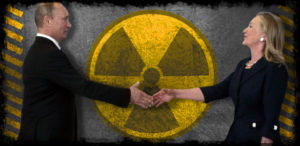by WorldTribune Staff, October 11, 2016
Hillary Clinton’s campaign surrogates relentlessly spin allegations of coziness between Moscow and Donald Trump but say nothing about a New York Times article last year that reported their candidate’s connection to a deal that allowed Russia to own a large share of America’s uranium.
The April 23, 2015 article in the Times was headlined: “Cash Flowed to Clinton Foundation Amid Russian Uranium Deal”.
 The article states: “The deal made Rosatom one of the world’s largest uranium producers and brought Mr. Putin closer to his goal of controlling much of the global uranium supply chain. But the untold story behind that story is one that involves not just the Russian president, but also a former American president and a woman who would like to be the next one.
The article states: “The deal made Rosatom one of the world’s largest uranium producers and brought Mr. Putin closer to his goal of controlling much of the global uranium supply chain. But the untold story behind that story is one that involves not just the Russian president, but also a former American president and a woman who would like to be the next one.
“At the heart of the tale are several men, leaders of the Canadian mining industry, who have been major donors to the charitable endeavors of former President Bill Clinton and his family. Members of that group built, financed and eventually sold off to the Russians a company that would become known as Uranium One.”
The deal “gave the Russians control of one-fifth of all uranium production capacity in the United States,” the article continued. “Since uranium is considered a strategic asset, with implications for national security, the deal had to be approved by a committee composed of representatives from a number of United States government agencies. Among the agencies that eventually signed off was the State Department, then headed by Mr. Clinton’s wife, Hillary Rodham Clinton.”
During the period when the deal with Russia was under consideration, the Clinton Foundation reportedly took in $2.6 million from Uranium One. Its contributions were not disclosed by the Clintons, despite an agreement Hillary Clinton had reached with the Obama White House to publicly identify all donors.
During this period, Bill Clinton also received $500,000 for a Moscow speech from a Russian investment bank that was promoting Uranium One stock. This was more than his usual speaking fee.
The deal left huge amounts of U.S. uranium under the control of Russia. The New York Times estimates this share at 20 percent. But Peter Schweizer, the author of Clinton Cash, say that it amounts to up to 50 percent of projected U.S. uranium output.
Other people with ties to Uranium One made donations to the Clinton Foundation as well, the Times report said.
The report noted that the only Uranium One official to give to the Clinton Foundation was Ian Telfer, the chairman, “and the amount was relatively small: no more than $250,000, and that was in 2007, before talk of a Rosatom deal began percolating.
“But a review of tax records in Canada, where Mr. Telfer has a family charity called the Fernwood Foundation, shows that he donated millions of dollars more, during and after the critical time when the foreign investment committee was reviewing his deal with the Russians. With the Russians offering a special dividend, shareholders like Mr. Telfer stood to profit.
“Mr. Telfer’s undisclosed donations came in addition to between $1.3 million and $5.6 million in contributions, which were reported, from a constellation of people with ties to Uranium One or UrAsia, the company that originally acquired Uranium One’s most valuable asset: the Kazakh mines,” the report continued. “Without those assets, the Russians would have had no interest in the deal.”
While the United States gets one-fifth of its electrical power from nuclear plants, it produces only around 20 percent of the uranium it needs, and most plants have only 18 to 36 months of reserves, according to Marin Katusa, author of “The Colder War: How the Global Energy Trade Slipped From America’s Grasp.”
“The Russians are easily winning the uranium war, and nobody’s talking about it,” said Katusa, who explores the implications of the Uranium One deal in his book. “It’s not just a domestic issue but a foreign policy issue, too.”
